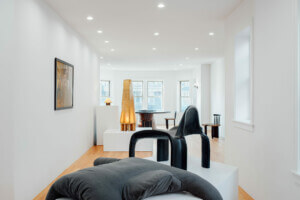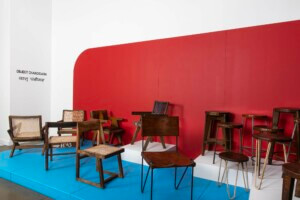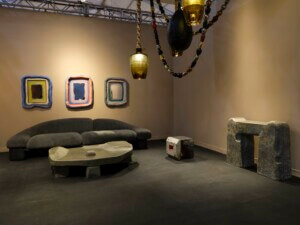It’s usually not a good idea to put your feet through a vintage wooden bench, but, in his latest show, artist Erwin Wurm is asking visitors to do just that.
In Wurm’s One Minute Sculptures series, which began in 1997, members of the public follow the artist’s written directions to realize a sculpture—moving around a low plinth to engage (or subvert) the everyday function of fruit, cleaning supplies, and here, midcentury modern furniture.
The latest iteration of these short sculptures references Ethics, Spinzoa’s seminal philosophic work that questioned the existence of free will. The success of the art, Wurm says, is directly correlated with how well the person follows his instructions.
Today, at Ethics demonstrated in geometrical order, visitors to Lehmann Maupin will realize the sculptures of the Austrian artist via famous furniture he has enhanced with embroidered and carved directions. The Architect’s Newspaper (AN) sat down with Wurm to discuss Alvar Aalto, the strangeness of everyday objects, and the stubborn persistence of midcentury design:
AN: Why did you turn to Spinoza for this exhibition?
Erwin Wurm: Spinoza, especially in [Ethics], he said free will doesn’t exist, it’s God’s will. Scientists now have determined that free will really doesn’t exist. Now, 500 years later, I’m asking the same questions. This I find exciting and interesting. When people accept my invitation to follow my instructions, they give up their free will.
Do people ever try to exert their own free will and not follow the directions?
Sure, they can, they’re allowed to. But then it’s not a piece of mine. Actually, when you Google “one minute sculptures,” you see many one minute sculptures, people use the idea. It’s nice, it’s interesting, but it’s no longer a piece of mine.
Why did you decide to use midcentury modern furniture in these latest One Minute Sculptures?
Since 15 years ago, midcentury furniture came back in a big way. When you open a magazine about housing or interior design, these midcentury furnishings are there. They became such a big thing. I found it exciting, and it raised questions for me. People start to define themselves through furniture. When you see the buildings and apartments of famous and successful people, you don’t see the people. You see the furniture.
Why did you select the pieces that you did?
I used Alvar Aalto because I always found him exciting. He’s from Finland, and he has this specific relationship to American design. We got the furniture at an auction in Chicago.
Some of the furniture in the series are very expensive, and because of that, there’s a meaning people assign to the pieces beyond the design. How do you hope to question the relationship people have with high-value objects?
Every material around is the basis for a new art piece. Recently, in Austria, I had a big show that included three artworks from very famous artists, including Robert Rauschenberg. I added a Rauschenberg to a piece of mine, so I started a discussion that not only every object, or mood, or thought could be the start of a new piece, but also already-finished art can be the start of a new work.
You use humor in your work to draw people in, but that humor can mask as much as it reveals. What do you hope people get out of their engagement with your sculptures?
It’s not so much the humor I’m interested in, it’s the paradox. What I like in humor is part of the paradox.
For me, to be in this world, to connect with the world, to be able to look from another perspective of reality. We all live in the same world, but we all live in different realities—your reality is very different from mine, or from a person in the wilderness, still hunting with bow and arrows, but we all live in the same time. I find it exciting to change perspective, to look at the world from a different angle, that’s what my work is about, I think.
What’s the relationship between the melting buildings’ organic excess (pictured, left) and the furniture’s precise geometry?
They are both objects of our world, created by human beings. The furniture and the architecture, or the telephone, all these things.
I always try to transfer or deform them, so the beginning is the same but the form is different. I changed the meaning of the object. One is an object with which you can relate specifically by following the instructions I give, and the other one is not an open piece, so you just can look.
In past iterations of the Organization of Love you used bottles to create a particular relationship between people. Why use an ottoman this time?
It’s exciting to use larger objects. At the beginning, the objects were small. Our interfering in the world uses a specific language which is related to a specific time. This inhabits a certain understanding of reality, certain political and social constructions. The 1950s were different than the 90s, or now. In the 50s the midcentury furniture related to this postwar society. This created a totally different aesthetic than nowadays. I’m interested in all these things that interfere in between.
Many midcentury designers wanted their furniture to be beautiful, functional, and available to the masses. But now that ottoman retails for like, $4,000.
I know.
How does that change people’s attitudes towards the objects?
The icon was one of the greatest inventions of the 20th century. An icon needs mass media to exist, and all this furniture are kind of icons now. And that interests me. That’s one of the reasons I use these objects.
This big company in Austria, it built these wooden banded structures—chairs for the working class—that very quickly became chairs for the upper class. That was not only because of the aesthetics but also an [evolving] understanding of early industrial design. Prouvé was the same, early on, Royère, Jeanneret—these French designers, they’re extremely expensive now.
Do you have midcentury furniture in your home?
Yes, I have Prouvé and all these things. But I caught myself, I stepped into the same trap that everyone did, because I got attracted all of a sudden by a certain understanding of quality which is only dealing in an interest of time, meaning that contemporary design is less valuable under certain circumstances than an older design. This relays a very specific understanding of how societies function, how the market functions, and how desire functions.
All of a sudden, we desire something that is rarer than what is produced now. Look at cars. We love [these] big new cars, but the old cars—with their much more extraordinary form—attract so many people. But those cars were not extraordinary in the past—they look extraordinary now in relation to mass design of the present. That discrepancy is exciting.
When you realized you were attracted to the value the furniture represents—when did you start to question that?
I started to question it when I came to my house and realized that it looked like one of those interiors magazines, because they all have Prouvé and Perriand, and whatever they’re called, and Aalto, and all the American designers. It was no longer a specific taste, it turned into a common taste. So I wound up doing my own furniture by deconstructing old furniture from the 30s.
You’re from an architecture publication, right?
Yes.
There are so many great designers now but they don’t get the same attention. Maybe Magnusson and others, but they don’t get the same prices. It’s always interesting how things grow old, get out of the normal interest, disappear, and come back and become exciting. The same happens with art.
(This interview was edited and condensed for clarity.)
Ethics demonstrated in geometrical order runs through May 26. Check Lehmann Maupin’s website for more information.










